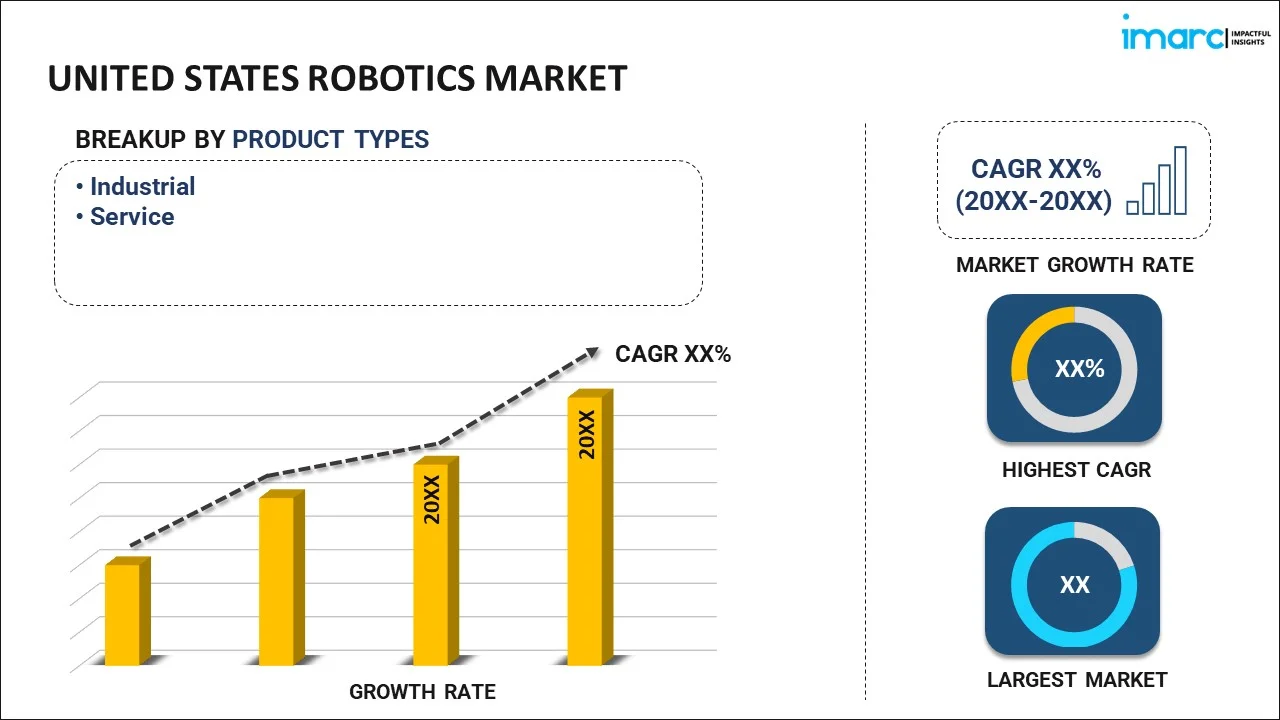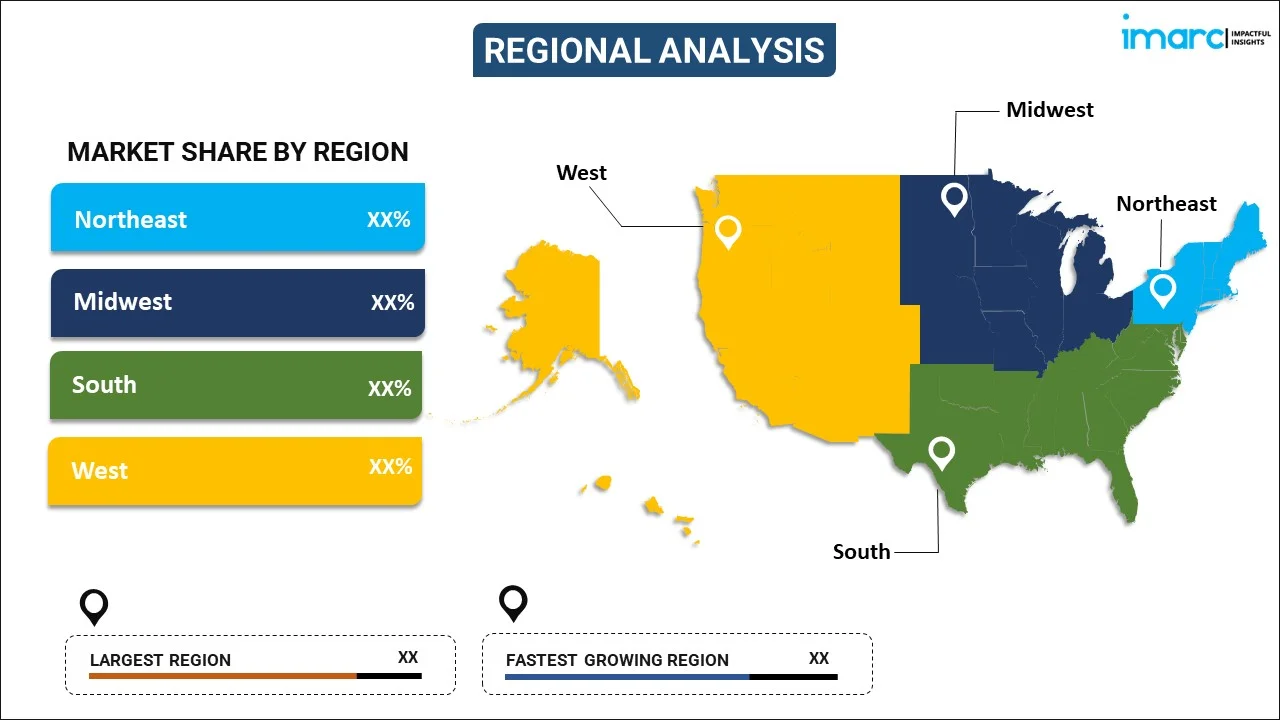
United States Robotics Market Report by Product Type (Industrial, Service), and Region 2025-2033
United States Robotics Market Size and Share:
United States robotics market size reached USD 13.1 Billion in 2024. Looking forward, IMARC Group expects the market to reach USD 19.1 Billion by 2033, exhibiting a growth rate (CAGR) of 3.8% during 2025-2033. The escalating demand for advanced technologies that contribute to enhanced safety in perilous environments, heightened production efficiency, cost reduction, and product quality improvement is primarily driving the market growth across the country.
|
Report Attribute
|
Key Statistics
|
|---|---|
|
Base Year
|
2024 |
|
Forecast Years
|
2025-2033
|
|
Historical Years
|
2019-2024
|
| Market Size in 2024 | USD 13.1 Billion |
| Market Forecast in 2033 | USD 19.1 Billion |
| Market Growth Rate (2025-2033) | 3.8% |
Robotics encompasses the exploration of robots and their conceptualization, evolution, construction, operation, and practical application. It involves the deployment of automated machines to execute tasks that are either too intricate or hazardous for human involvement. These robotic systems find utility across a spectrum of functions, including assembly, inspection, welding, painting, cutting, and packaging. The significance of robotics has grown significantly across various sectors, spanning manufacturing, healthcare, and defense. Moreover, it harbors the potential to transform operational methodologies in diverse industries, potentially diminishing reliance on human labor while boosting operational efficiency. The scope of robotics extends to creating interactive robots capable of engaging with humans and their surroundings, with applications extending to oceanic and space exploration, as well as harsh environments. Furthermore, robotics has facilitated the development of autonomous vehicles, including self-driving cars and drones, and has ventured into realms such as surgical procedures, search and rescue operations in disaster-stricken areas, and medical diagnostics.
United States Robotics Market Trends:
Rise of Sustainable Products
Sustainability is now a dominant market trend because consumers become more environmentally aware. Eco-friendly behaviors like minimizing plastic packaging, renewable energy, and carbon-neutral products are increasingly being picked up by brands. This trend is not isolated to niche areas; big players like Apple and Unilever are making significant investments in sustainability. Gen Z and Millennials consumers pay a premium for eco-friendly products, which drives industries from fashion to food. Governments, too, are implementing stricter environmental policies, compelling businesses toward sustainable operations. Hence, sustainable business models can drive brand loyalty and tap a larger group of environmentally aware consumers. Overall, the call for transparency, fair sourcing, and responsible production is changing markets around the world and creating opportunities for innovative, environmentally responsible products and services.
Growth of E-commerce and Digitalization
The sudden boom in e-commerce is revolutionizing the way companies connect with customers. With higher internet penetration and smartphone usage across the globe, online retailing is substituting conventional brick-and-mortar stores. The COVID-19 pandemic helped accelerate the trend as even small and medium businesses went digital. Amazon, Alibaba, and Shopify are at the forefront by providing frictionless digital experiences, one-to-one marketing, and same-day delivery services. Payment methods like digital wallets and Buy Now, Pay Later (BNPL) are also improving convenience and customer satisfaction. Social commerce—purchasing products directly through social media apps—is becoming increasingly popular, especially with younger consumers. The movement to online channels means companies need to spend money on digital marketing, cybersecurity, and easy-to-use web designs to remain competitive. In general, digital transformation is no longer a choice; it is necessary for the survival and expansion of businesses in almost every industry.
Increasing Importance of Artificial Intelligence (AI)
Artificial Intelligence is transforming sectors by making processes automated, efficient, and enhancing customer experience. Chatbots that service customer inquiries to predictive analytics that inform business decisions, AI applications are far and wide across healthcare, finance, retail, and manufacturing. Firms employ AI for personalization—suggesting products based on consumer behavior—which contributes to sales and user engagement. In production, robotics with AI enhance quality checks and minimize human errors. In addition, generative AI technologies are revolutionizing creative industries by creating content, designs, and even music, providing new possibilities for brands to connect with audiences. Both tech giants and startups are spending a lot in developing AI to catch up. Yet, ethical issues such as data privacy and algorithmic bias continue to pose significant challenges. As AI technology advances, its penetration will only intensify, fundamentally reshaping the way companies do business, innovate, and serve their markets around the world.
United States Robotics Market Segmentation:
IMARC Group provides an analysis of the key trends in each segment of the market, along with forecasts at the country level for 2025-2033. Our report has categorized the market based on product type.
Product Type Insights:

- Industrial
- Breakup by Type
- Articulated
- Cartesian
- SCARA
- Cylindrical
- Others
- Breakup by Type
- Service
- Breakup by Type
- Personal and Domestic
- Professional
- Breakup by Application
- Household Applications
- Entertainment Applications
- Defense Applications
- Field Applications
- Logistics Applications
- Healthcare Applications
- Infrastructure Applications
- Mobile Platform Applications
- Cleaning Applications
- Others
- Breakup by Type
The report has provided a detailed breakup and analysis of the market based on the product type. This includes industrial [breakup by type (articulated, cartesian, SCARA, cylindrical, and others)] and service [breakup by type (personal and domestic and professional) and breakup by application (household applications, entertainment applications, defense applications, field applications, logistics applications, healthcare applications, infrastructure applications, mobile platform applications, cleaning applications, and others)].
Regional Insights:

- Northeast
- Midwest
- South
- West
The report has also provided a comprehensive analysis of all the major regional markets, which include the Northeast, Midwest, South, and West.
Competitive Landscape:
The market research report has also provided a comprehensive analysis of the competitive landscape in the market. Competitive analysis such as market structure, key player positioning, top winning strategies, competitive dashboard, and company evaluation quadrant has been covered in the report. Also, detailed profiles of all major companies have been provided.
Latest News and Developments:
- In May 2025, Badger Technologies, a division of Jabil Inc., launched its new Digital Teammate platform powered by next-generation autonomous robots. This solution integrates AI, computer vision, and RFID technology to boost workforce productivity, improve inventory accuracy, ensure food safety, and manage hazards. Designed to work alongside employees, the platform enhances data-driven decision-making and operational efficiency, offering advanced mobile analytics to streamline retail and grocery business workflows.
- In March 2025, Distalmotion completed its first U.S. sale of the DEXTER® Robotic Surgery System to Memorial Hermann Health System in Houston, Texas. DEXTER, designed for flexibility and ease in robotic-assisted surgeries, allows seamless use across multiple operating rooms and simplifies setup. Already successful in Europe with over 1,500 cases, DEXTER recently received FDA De Novo approval. Memorial Hermann aims to expand patient access to innovative, efficient robotic surgery through this technology.
- In January 2025, RoboSense's "Hello Robot" 2025 Global Launch Event featured the company's AI robotics strategy and new developments. A humanoid robotic prototype and three state-of-the-art digital LiDAR products—EM4 for ultra-long-range automotive application, E1R, the first entirely solid-state robotics LiDAR in the world, and Airy, a tiny hemispherical LiDAR with 360° vision—are among the highlights. These advancements mark RoboSense’s entry into a fully digitalized LiDAR era, showcased at CES 2025 in Las Vegas.
- In March 2024, ABB opened its upgraded US robotics headquarters and manufacturing facility in Auburn Hills, Michigan, reinforcing its commitment to the American market. The state-of-the-art site will develop AI-enabled robotics solutions for key sectors like packaging, logistics, healthcare, and EV production. This expansion is part of ABB’s $30 million US investment since 2019, aimed at addressing labor shortages, boosting sustainable operations, and supporting the growing demand for robotics across the Americas.
United States Robotics Market Report Scope:
| Report Features | Details |
|---|---|
| Base Year of the Analysis | 2024 |
| Historical Period | 2019-2024 |
| Forecast Period | 2025-2033 |
| Units | Billion USD |
| Scope of the Report | Exploration of Historical and Forecast Trends, Industry Catalysts and Challenges, Segment-Wise Historical and Predictive Market Assessment:
|
| Product Types Covered |
|
| Regions Covered | Northeast, Midwest, South, West |
| Customization Scope | 10% Free Customization |
| Post-Sale Analyst Support | 10-12 Weeks |
| Delivery Format | PDF and Excel through Email (We can also provide the editable version of the report in PPT/Word format on special request) |
Key Benefits for Stakeholders:
- IMARC’s industry report offers a comprehensive quantitative analysis of various market segments, historical and current market trends, market forecasts, and dynamics of the United States robotics market from 2019-2033.
- The research report provides the latest information on the market drivers, challenges, and opportunities in the United States robotics market.
- Porter's five forces analysis assist stakeholders in assessing the impact of new entrants, competitive rivalry, supplier power, buyer power, and the threat of substitution. It helps stakeholders to analyze the level of competition within the United States robotics industry and its attractiveness.
- A competitive landscape allows stakeholders to understand their competitive environment and provides an insight into the current positions of key players in the market.
Key Questions Answered in This Report
robotics is a branch of technology that designs, builds, and operates robots—machines capable of performing tasks autonomously or semi-autonomously. Combining engineering, computer science, and AI, robotics enables automation in industries like manufacturing, healthcare, and logistics, improving efficiency, precision, and safety while reducing human effort in repetitive or hazardous tasks.
The United States robotics market was valued at USD 13.1 Billion in 2024.
The United States robotics market is projected to exhibit a value of USD 19.1 Billion by 2033.
The United States robotics market is projected to exhibit a CAGR of 3.8% during 2025-2033.
The U.S. robotics market is driven by growing demand for automation to address labor shortages, enhance productivity, and improve workplace safety. Advancements in AI, machine learning, and sensor technology enable smarter, more flexible robots. Additionally, strong government support and rising adoption across industries like manufacturing, healthcare, and logistics fuel market expansion.
Need more help?
- Speak to our experienced analysts for insights on the current market scenarios.
- Include additional segments and countries to customize the report as per your requirement.
- Gain an unparalleled competitive advantage in your domain by understanding how to utilize the report and positively impacting your operations and revenue.
- For further assistance, please connect with our analysts.
 Request Customization
Request Customization
 Speak to an Analyst
Speak to an Analyst
 Request Brochure
Request Brochure
 Inquire Before Buying
Inquire Before Buying




.webp)




.webp)












